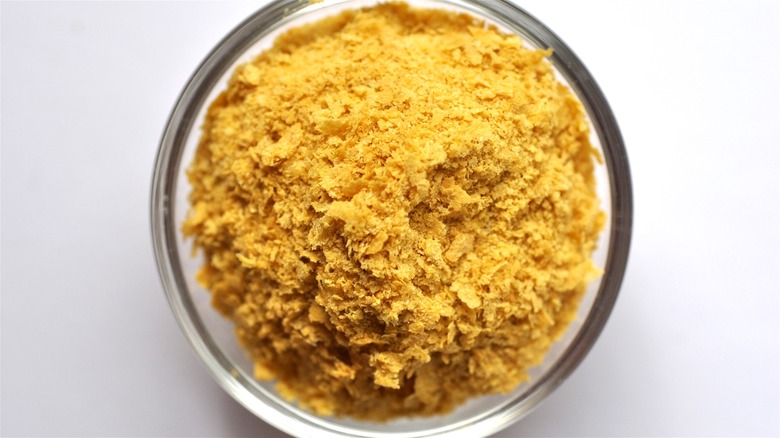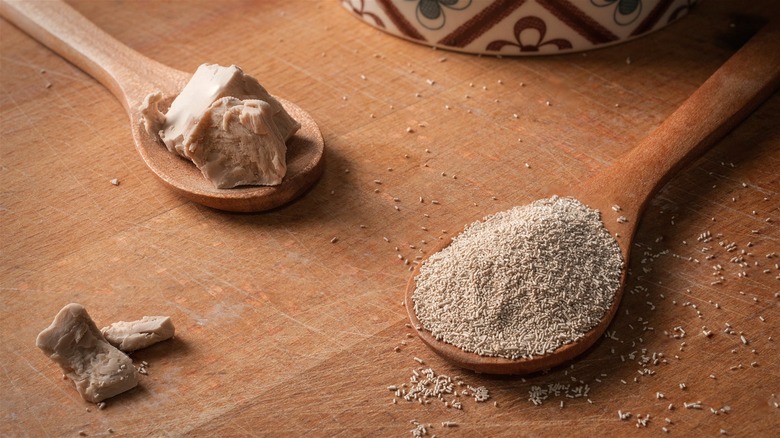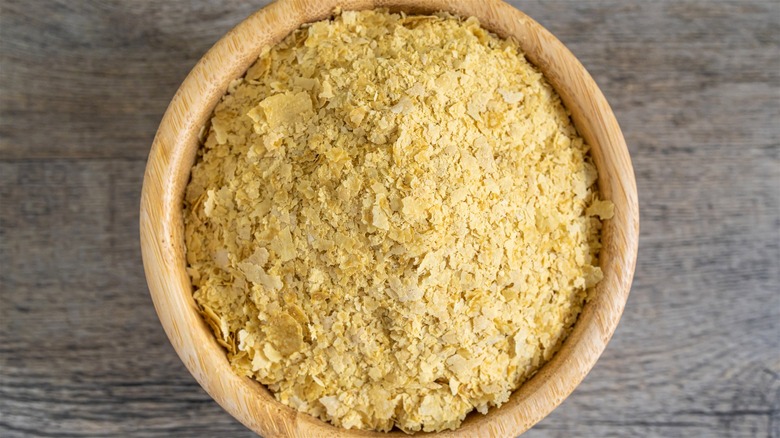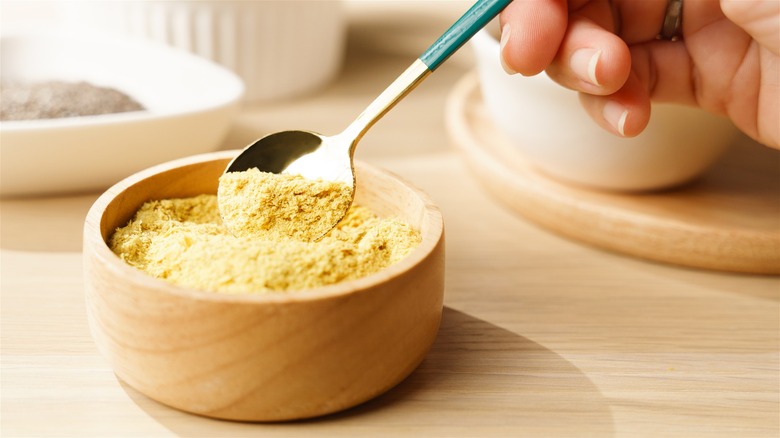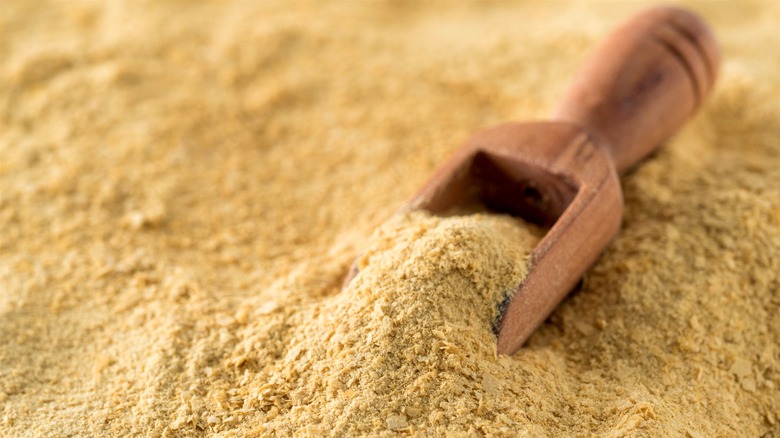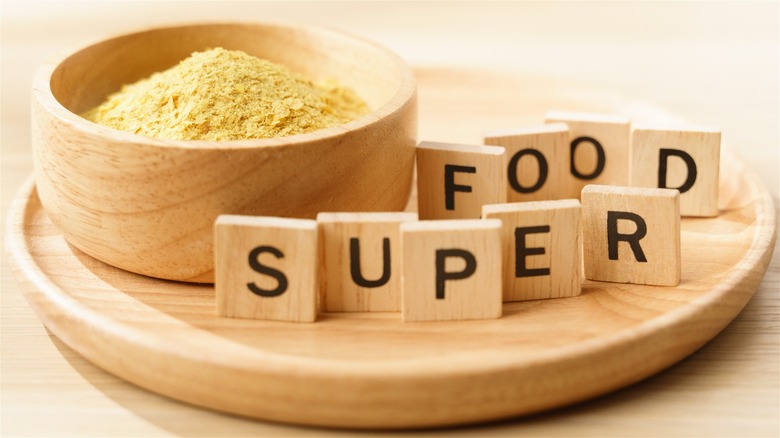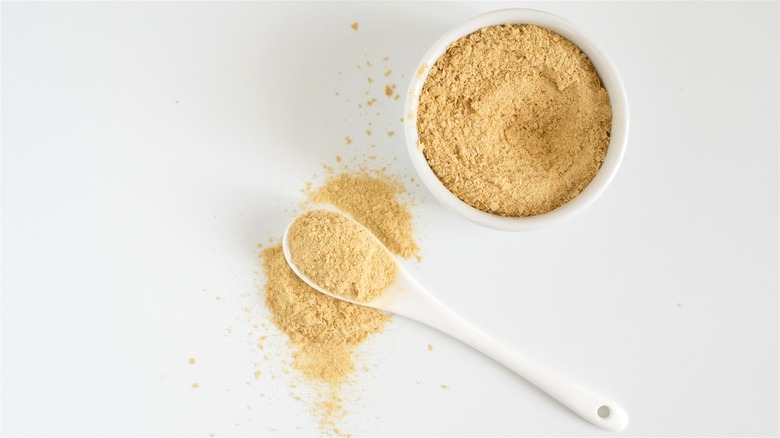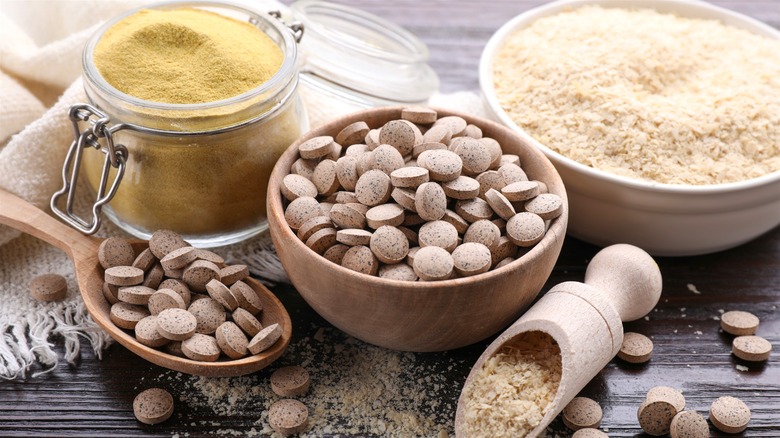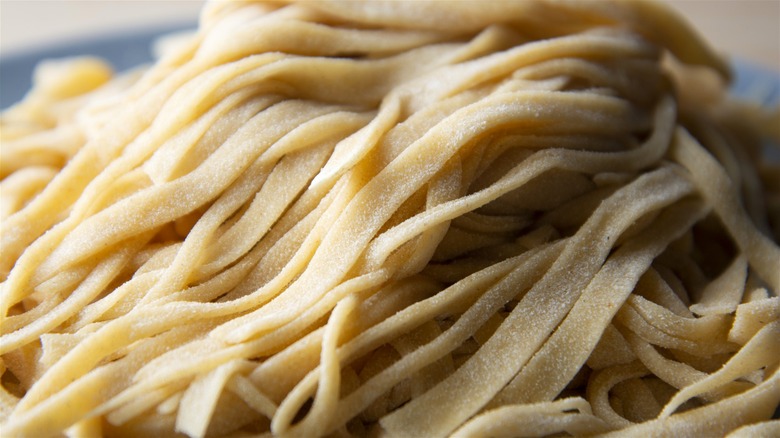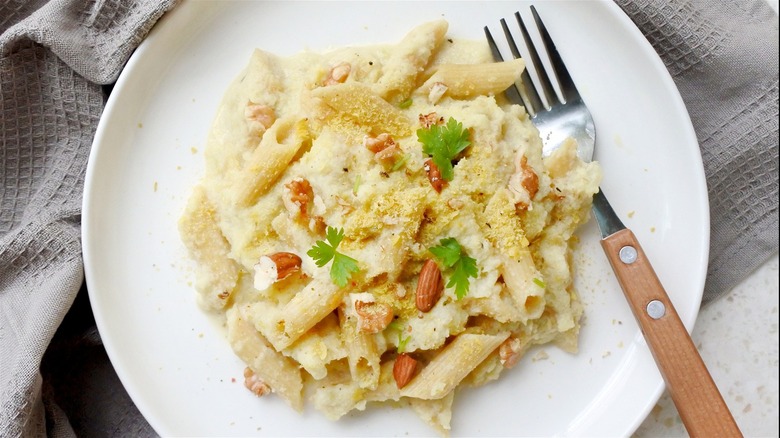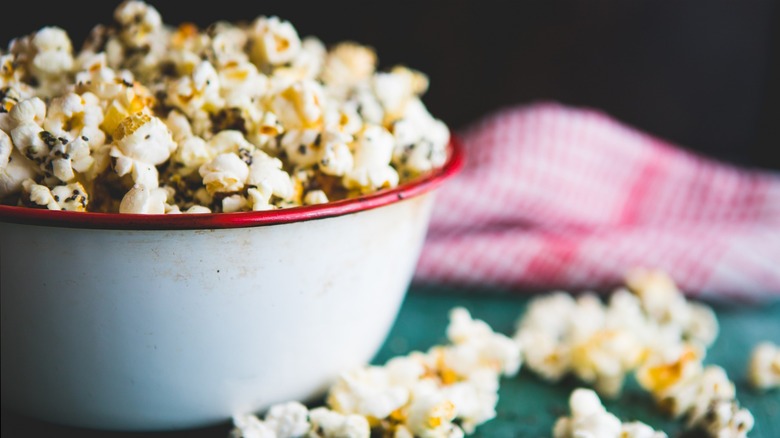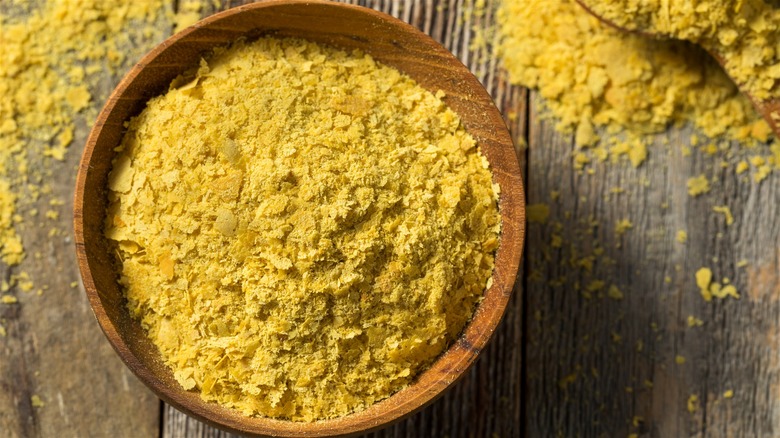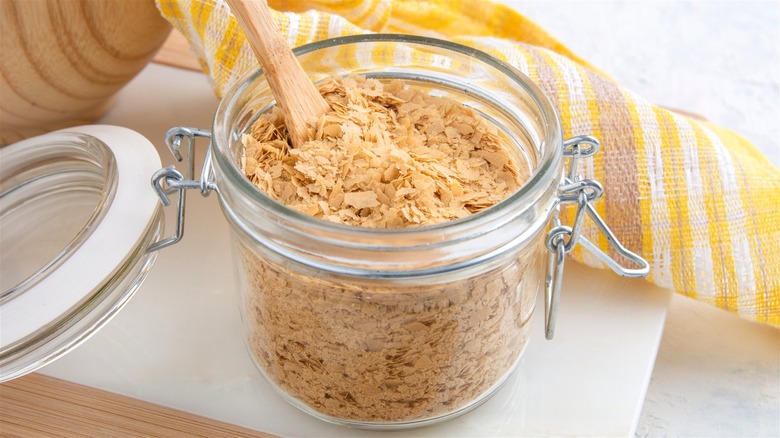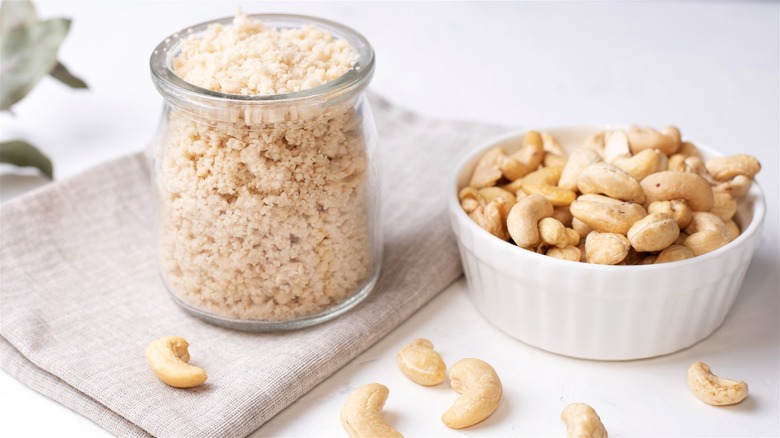15 Facts You Need To Know About Nutritional Yeast
Some people consider plant-based diets limiting. However, for many new vegans, this dietary shift brings opportunity for culinary exploration. There are so many fruits and vegetables you can turn into vegan steak and plant-based seafood alternatives to try to help you forget about "the real thing." Nothing is impossible for an adventurous plant-based cook with a well-stocked pantry — even cheese. And that's where nutritional yeast comes into play.
While its name and uncanny resemblance to fish food may make this ingredient unappetizing, you shouldn't knock it until you try it. This umami-packed seasoning, known affectionately as "nooch," offers an irresistibly savory, cheesy goodness and a hefty dose of B vitamins and protein. It's the same yeast you'd add to bread, only deactivated and processed to transform it into a valuable tool for plant-based cooking. So, whether you're a seasoned cook or just starting out on your plant-based journey, you should always have nutritional yeast in your pantry to take your culinary creations to new heights. Here are some of the important things you need to know about nutritional yeast before you cook with it.
Nutritional yeast stands out in the yeast family
As its somewhat off-putting name suggests, nutritional yeast shares its origins with brewer's and baker's yeast. All three come from a single-celled fungus called Saccharomyces cerevisiae, yet the difference between these varieties is so massive that substituting one for another would be a recipe for disaster.
Dry baker's yeast is dormant and requires a warm bath to unleash its gas-producing potential. This chemical reaction helps the yeast perform its key function: helping the dough rise. Brewer's yeast is used in beer making and for supplements. But although brewer's yeast packs valuable minerals, such as chromium, potassium, and selenium, it's too bitter to eat on its own. In contrast, nutritional yeast is derived from sweeter substrates like molasses and sugar beets and is deactivated during processing. It's a palatable supplement, a complete protein source rich in B vitamins, and is often used as a topping for savory foods.
It's been around for decades
If you're new to plant-based cooking and its staple ingredients, nutritional yeast might seem like a recent discovery. However, its use dates back decades. The nutritional potential of brewer's yeast was explored in the 1910s, just as the concept of vitamins started gaining traction. By the late 1920s, the Fleischmann's Yeast Company ad campaigns cemented yeast's superfood status with outrageous health claims meant to increase the sales of fresh yeast cakes. Two decades later, the Federal Trade Commission put a stop to these claims, but the collective memory of yeast as a health food remained.
Fortunately, in 1950, Red Star finally developed nutritional yeast in its present, flaked form – just in time for the rise of vegetarianism in the 1960s and 1970s. In 1975, "The Farm Vegetarian Cookbook" featured nooch in a melty plant-based cheese recipe, which was integral in showing consumers how valuable this seasoning could be. Despite an unfortunate dip in popularity in the 1980s, when the books on candida yeast ruined every other yeast's reputation, nutritional yeast returned with a vengeance in the 21st century.
The yeast is fermented and deactivated during processing
Nutritional yeast might come from the same species as the stuff that helps bread rise, but its unique production method turns it into an umami-packed seasoning. The strain of Saccharomyces cerevisiae is first placed into fermentation tanks to kickstart the culture. There, the yeast is fed a pure carb diet with molasses or beet-derived sugar under strictly monitored temperatures and pH conditions. The diet causes the yeast to release carbon dioxide and encourages the yeast to multiply.
After a few days of this gourmet lifestyle, the cells destined to become nooch are pasteurized and killed, stripping them of their leavening and fermenting powers. This process also releases amino acids like glutamic acid, which gives nooch its cheese-like umami flavor. As the yeast cells bite the dust, the drying process toasts them and adds a nutty note before they're packaged as flakes or powder.
Glutamic acid is responsible for nutritional yeast's flavor
What does nutritional yeast have in common with tomatoes, mushrooms, and seaweed? They're all umami-rich ingredients. This enticing fifth taste is deeply satisfying, savory, and integral to adding depth and complexity to dishes. Umami, caused by a non-essential amino acid called glutamate, is often found in protein-rich foods like meat. But it can also be found in some plants and fungi. Umami is also increased during fermentation, as is the case with kimchi, soy sauce, and miso paste. Nutritional yeast's glutamic acid is released after the yeast is pasteurized.
Nutritional yeast is often used as a seasoning, similar to monosodium glutamate (MSG), to enhance and round out the umami flavors of everything from roasted vegetables to plant-based casseroles and sauces. Besides imparting a concentrated umami complexity, this seasoning acts as a low-sodium alternative to enhance your meals with a sublime, slightly cheesy flavor that may make you forget it's vegan.
Nutritional yeast is packed full of nutrients
Although some affectionately call it "nature's Cheetos dust," its official name isn't false advertising. Nutritional yeast isn't just a flavor bomb; it's packed with healthy stuff, too. For one, it contains all the essential amino acids, rendering it a fully plant-based source of complete protein — and seasoned vegans know how rare that is outside of the animal kingdom. This is because complete proteins are most often and readily found in animal-based foods, like meat, poultry, fish, eggs, and dairy. More often than not, plant-based foods have some of the nine amino acids, but very few have all of them.
Besides being rich in protein, nooch is also full of B vitamins, which are needed for energy and metabolic function. One of these B vitamins is B12, which is otherwise limited in plant-based diets. A single teaspoon of fortified nutritional yeast contains over 150% of the recommended daily intake of B12. Plus, it boasts small amounts of zinc, iron, potassium, and fiber.
Most people can eat nutritional yeast every day
The more you learn about nutritional yeast, the more tempting it is to put it on everything. At first glance, it's virtually perfect. It has all nine essential amino acids, is rich in protein, is naturally gluten-free, and has an impressive profile of B vitamins. You can also easily integrate nutritional yeast into every meal. For example, start your morning with a bowl of savory oats seasoned with powder, use it in a salad dressing for lunch, and whip up a savory pasta sauce with it for dinner.
However, those sensitive to glutamate might want to avoid eating nutritional yeast, as it's a major part of the seasoning. Certain medical conditions, including Crohn's disease, and other individuals with yeast intolerances might want to stave off, too. Moreover, nutritional yeast may trigger headaches in individuals with chronic migraines due to the presence of tyramine.
There are many forms of nutritional yeast
It's easy to mistake nutritional yeast flakes for fish food and the powdered version for Cheetos dust. Indeed, the yellow substance may not look delicious, but we assure you that all that will change when you try it. The powder is technically interchangeable with the flakes, but you should bear in mind that you'll only need half as much of the powder if you're swapping it for flakes. You can also reap its nutritional benefits by taking it as a fortified supplement.
Many forms of yeast are on the market, and you'll also find fortified or non-fortified options. Non-fortified yeast only contains naturally present vitamins and amino acids, while fortified yeast adds synthetic vitamins to enhance the yeast's nutritional profile. This might include extra iron or beta-glucan. Fortification also increases the B12 content, which is one draw for plant-based eaters who cannot get this micronutrient from animal-based sources.
Vegan cheeses wouldn't be the same without it
If there's one thing that nooch is universally known for, it is its signature cheesy flavor. While those who still eat cheese debate its likeness to the "real thing," many plant-based eaters couldn't be happier with the umami zing it brings to traditionally cheese-filled dishes. Ever since nutritional yeast was first published in vegetarian cookbooks in the 1970s, the ingredient has taken off and has been used in many different vegan cheese interpretations.
Whether you're making dairy-free mozzarella or a vegan cheese spread, you'll find some similarities across recipes. Many call for soaking and blending raw cashews into a creamy mass supplemented with oil for a satisfying mouthfeel, lemon juice or vinegar for a characteristic tang, some starch for stretchiness, and nutritional yeast for a natural cheesy flavor. Not all include cashews, though; some recipes will use leftover starch water from washed flour seitan, plant-based milk, tofu, or vegetables. Regardless, you'll be hard-pressed to find a recipe that doesn't call for nooch.
It's the key ingredient to chickenless stock
Some plant-based eaters still seek out the flavors of beloved animal-based dishes, including stocks and broths. This is where nutritional yeast's umami flavor can be an asset. While providing a cheesy flavor may be nooch's most celebrated role, its potential in a plant-based kitchen goes far beyond that. It can easily give vegan chicken bouillon a kick of flavor because the glutamic acid meshes well with other ingredients. Some even liken the flakes to the dehydrated roast chicken skin.
When combined with other flavor bombs like miso paste and garlic powder, nooch can transform the flavor of meatless products like homemade seitan. But you don't need to master plant-based meats to enjoy the miraculous effects of nooch. Melt the golden flakes into your vegetable stocks, or create your own chickenless bouillon mix with ingredients like nooch, salt, powdered garlic and onion, dried herbs, poultry seasoning, and some freshly cracked pepper.
Nutritional yeast can alter dough texture
The role of Saccharomyces cerevisiae in baking can hardly be overstated. We are all familiar with adding active yeast to a wheat flour dough and watching it feast on starches and sugars, emitting gas in the process. This vital function of the humble fungi helps the dough rise without adding chemical leaveners such as baking soda or powder. But what could nutritional yeast, which has been deactivated and thus stripped of its leavening power, possibly contribute here?
Nutritional yeast also plays an important culinary role as a dough relaxer. It is packed with glutathione, an antioxidant comprised of three amino acids: glycine, cysteine, and glutamic acid. This compound enhances the softness and extensibility of gluten doughs and is capable of reducing the amount of time needed to knead and rest the dough. During the mixing process, it acts as a reducing agent, breaking down certain gluten bonds and forming new connections that help to stretch the gluten molecules. This ability is especially important when making homemade seitan (which is basically a gluten-based dough) because it prevents a tough, rubbery texture.
You can elevate your sauces and dressings with nutritional yeast
Nutritional yeast is an obvious solution for bringing that sought-after rich flavor to traditionally dairy-based sauces like Alfredo and nacho cheese. But an adventurous cook will not relegate these umami-packed flakes to "cheesy" sauces alone. Instead, they will sneak them into plenty of other recipes that aren't necessarily missing that flavor element but could still benefit from nutritional yeast.
For example, a couple of tablespoons of nooch can seriously elevate a basic pizza sauce. While tomatoes are already rich in umami, a little bit of nutritional yeast can take this recipe to a new level. You can make an extra-flavorful pizza sauce that is completely vegan and includes a classic combination of tomatoes, garlic, and herbs. The nooch brings in that extra flavor, a lightly cheesy undertone, and extra vitamins.
Its thickening properties are also a welcome bonus in dense sauces like vegan gravy. Alternatively, you could create superior salad dressings with it, as it works well in vinaigrette-based and creamy concoctions.
Sprinkle nutritional yeast on your favorite foods
You don't have to be passionate about home cooking or creating vegan alternatives to cheesy and meaty dishes to reap the benefits of nutritional yeast. It's so easy to incorporate the flakes or power into ready-made meals and snacks for a fun and nutritious boost. One food that you should consider adding nutritional yeast to is popcorn. Just make sure to coat the fluffy kernels with butter or oil before adding a generous sprinkle of nooch so it sticks.
Nutritional yeast pairs well with many textures and flavors. It will be a welcomed addition to avocado toast, congee, tofu scramble, and pasta. Toss some roasted chickpeas in it, and you'll have an easy, protein-filled snack. Alternatively, you can mix it with other spices to create unique seasoning mixes that will enhance the flavor of vegetables. Roasted cauliflower, cheesy kale chips, or a hearty salad bowl can all benefit from a sprinkle of nooch.
Nutritional yeast is becoming more popular
It's mind-boggling to think that there was a time when people underestimated or even mocked, the power of nutritional yeast. It is no longer a hippie food of the 20th century, a health fad for vegans, or a unique instrument reserved for plant-based chefs. If market research tells us anything, it is that the popularity of nooch is on the rise.
According to a market research report, the global nutritional yeast market is on fire. In 2022, its market value was estimated to be around $428.1 million and is expected to reach a whopping $999.5 million by 2032. In Europe, nutritional yeast sales take up 35% of the global market; this is likely attributed to a growing interest in plant-based and health foods. Meanwhile, North America has a 24.5% market share, but it's assumed to grow as more consumers choose to eat plant-based or explore new ingredients.
It's easy to find nutritional yeast
When it comes to nutritional yeast, there's no shortage of brands vying for space on your pantry shelf. Over a dozen companies, including popular brands like Bragg and Bob's Red Mill, offer the delicious substance in flake and powder form. Red Star, one of the OGs on the nutritional yeast scene, offers a fortified product for consumers.Though less common, we recommend Shiloh Farms for non-fortified nooch and a synthetic-free ingredient list. Trader Joe's even carries budget-friendly nutritional yeast.
Despite its growing popularity, nooch might not yet be a regular fixture at your local grocery store, but health food stores and bigger chains like Whole Foods might have it in stock. Otherwise, you can always count on Amazon or other online retailers to help you get your nooch fix.
Regardless of the brand you pick, store your yeast in an airtight container and away from heat and sunlight so that you can enjoy it within three years of opening. And if it starts looking funky or smelling off, it's time to bid it farewell.
There are many nutritional yeast substitutes
Nutritional yeast is, without a doubt, a unique ingredient. It wears many hats, but it always delivers on the umami and nutritional front. With that said, you'll be hard-pressed to find a perfect one-for-one swap for this specialty product — but it's not impossible. In fact, there are many substitutes for nutritional yeast that you can rely on in a pinch. For example, you can swap in cashews, dried mushrooms, miso, and bouillon cubes to mimic the umami intensity of the yeast.
If you only use nooch for its nutritional benefits, look into its deactivated cousin, brewer's yeast. Its flavor is far less palatable, but a couple of teaspoons can thicken a cheese sauce nonetheless. Vegan parmesan cheese is a gourmet substitute for recipes where nooch is used as a finishing touch. And don't forget about Marmite; the concentrated yeast spread is a natural substitute for that strong, yeasty flavor.
